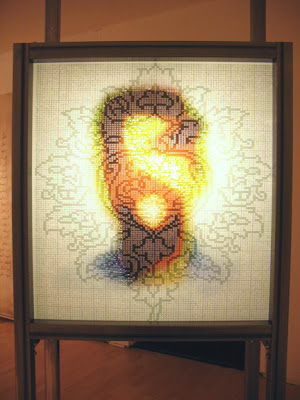
Note: This exhibition is scheduled to close on 6/30/07.
It was not long after the 9/11 attacks when artist Taraneh Hemami, a native of Iran, came across a U.S. government poster showing headshots of the “most wanted international terrorists.” Or rather, she came across a small, low-resolution image of this poster (see above). The faces were not identifiable although many of the figures appeared to be Middle Eastern. As the artist commented to me, “They could be anybody.”
Hemami has been exploring this material for awhile, and her current exhibition at Intersection for the Arts in San Francisco uses it as the kernel for a superb installation. Through a variety of devices, she evokes the climate of ignorance, fear, and depersonalization that now influences how people in the West react to people of Middle Eastern descent. With a sardonic flourish, she calls the show “Most Wanted.”
The exhibit begins in the stairway that leads to the second-floor exhibition space. Visitors encounter a stair carpet imprinted with Middle Eastern names (in English) running down the center in a single column. It looks a bit like a memorial. You can avoid stepping on the names if you widen your gait a bit. Further up, though, you reach a carpet that has two columns of names. Here it’s hard to proceed without treading on the names. At the top, entering the gallery, you see a timeworn wall covered in Farsi script, repeating the names on the stairs. (Images below.)


 The blurred headshots are put to several uses. In one, the entire government poster is transformed into a decorative bead curtain, like a cozy adornment in an Iranian home. (Images below.)
The blurred headshots are put to several uses. In one, the entire government poster is transformed into a decorative bead curtain, like a cozy adornment in an Iranian home. (Images below.)
 Some of the single headshots, reproduced as large copies, are mounted in a lightbox array that has two sides. The outward side is meant to suggest the bars of imprisonment. The inner portion, where floral carpet patterns are added to the images, is meant to recall the photos seen on Iranian gravesites. (Images below.)
Some of the single headshots, reproduced as large copies, are mounted in a lightbox array that has two sides. The outward side is meant to suggest the bars of imprisonment. The inner portion, where floral carpet patterns are added to the images, is meant to recall the photos seen on Iranian gravesites. (Images below.)
 On a wall in the rear stairwell, a video projection shows a series of headshots morphing into each other. What's disturbing is that the inability to read these images begins to feel like a defect of mind. (Image below.)
On a wall in the rear stairwell, a video projection shows a series of headshots morphing into each other. What's disturbing is that the inability to read these images begins to feel like a defect of mind. (Image below.) Hemami's imagery addresses a social and psychological condition, but it's interesting to note that there is also a medical condition, called prosopagnosia, which limits the recognition of faces. There is a brief but informative Wikipedia article on this rare condition.
Hemami's imagery addresses a social and psychological condition, but it's interesting to note that there is also a medical condition, called prosopagnosia, which limits the recognition of faces. There is a brief but informative Wikipedia article on this rare condition.


3 comments:
Please. Not WIKIPEDIA!!! Do you really want people thinking you actually trust that high school slam book?
I'm off to mourn the death of critical thinking...
The article I recommended seemed a reasonable introduction to the topic. The references, bibliography, and links for the article are of good quality.
In my view, it is as naïve to reject Wikipedia material out of hand as it is to assume that all of its material is well researched. Critical thinking means putting information into a larger context, in order to separate what is shoddy from what is sound. This includes judging whether an article in Wikipedia (or any source) is useful, or fatally flawed.
I am aware of the criticisms directed at Wikipedia, many of them justified. I hope the new model, the Citizendium, can carry the open source model for an encyclopedia to the next level.
In any case, it will remain true that any source of information, no matter how authoritative it appears, is subject to evaluation and correction. We all need to remain alert, read widely, and continue to sift what is presented to us.
She is genius!
I think this is a great cultural masterpiece.
Cheers,
Caroline
Post a Comment